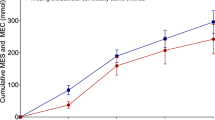Abstract
A controversy exists in the literature as to the most appropriate sodium concentration for maintenance parenteral fluids. The purpose of this study was to evaluate urinary sodium composition in otherwise healthy children in order to help determine if 0.9% sodium chloride (NaCl) would be an appropriate parenteral fluid. The composition of urinary sodium was evaluated over 24 h in 100 otherwise healthy children aged 3–18 years referred to a pediatric nephrology outpatient clinic for hematuria or proteinuria. The average urine sodium concentration was 158 ± 59 mEq/l, similar to that of 0.9% NaCl (154 mEq/l). Urine sodium excretion was 2.9 ± 1.3 mEq/kg per 24 hours, and urine flow rate was 0.9 ± 0.4 ml/kg per hour. It was concluded that healthy children generate free water via the excretion of a hypertonic urine. It is unlikely that 0.9% NaCl would result in hypernatremia when administered in parenteral fluids.
Similar content being viewed by others
References
Dabbagh D, Atiya B, Fleischmann LE, Gruskin AB (1999) Fluid and electrolyte therapy. In: Burg DP, Ingelfinger JR, Wald ER, Polin RA (eds) Gellis & Kagan’s current pediatric therapy, 16th edn. Saunders, Philadelphia, pp 860–870
Moritz ML, Ayus JC (2003) Prevention of hospital-acquired hyponatremia: a case for using isotonic saline. Pediatrics 111:227–230
Holliday MA, Friedman AL, Segar WE, Chesney R, Finberg L (2004) Acute hospital-induced hyponatremia in children: a physiologic approach. J Pediatr 145:584–587
Mosteller RD (1987) Simplified calculation of body-surface area. N Engl J Med 317:1098
Andersen LJ, Norsk P, Johansen LB, Christensen P, Engstrom T, Bie P (1998) Osmoregulatory control of renal sodium excretion after sodium loading in humans. Am J Physiol 275:R1833–R1842
Heer M, Baisch F, Kropp J, Gerzer R, Drummer C (2000) High dietary sodium chloride consumption may not induce body fluid retention in humans. Am J Physiol Renal Physiol 278:F585–F595
Food and Nutrition Board, Institute of Medicine (2004) Sodium and chloride. Dietary reference intakes for water, potassium, sodium, chloride, and sulfate. National Academies Press, Washington, DC, pp 247–392
Taylor D, Durward A (2004) Pouring salt on troubled waters. Arch Dis Child 89:411–414
Hatherill M (2004) Rubbing salt in the wound. Arch Dis Child 89:414–418
Author information
Authors and Affiliations
Corresponding author
Rights and permissions
About this article
Cite this article
Moritz, M.L. Urine sodium composition in ambulatory healthy children: hypotonic or isotonic?. Pediatr Nephrol 23, 955–957 (2008). https://doi.org/10.1007/s00467-008-0757-6
Received:
Revised:
Accepted:
Published:
Issue Date:
DOI: https://doi.org/10.1007/s00467-008-0757-6




